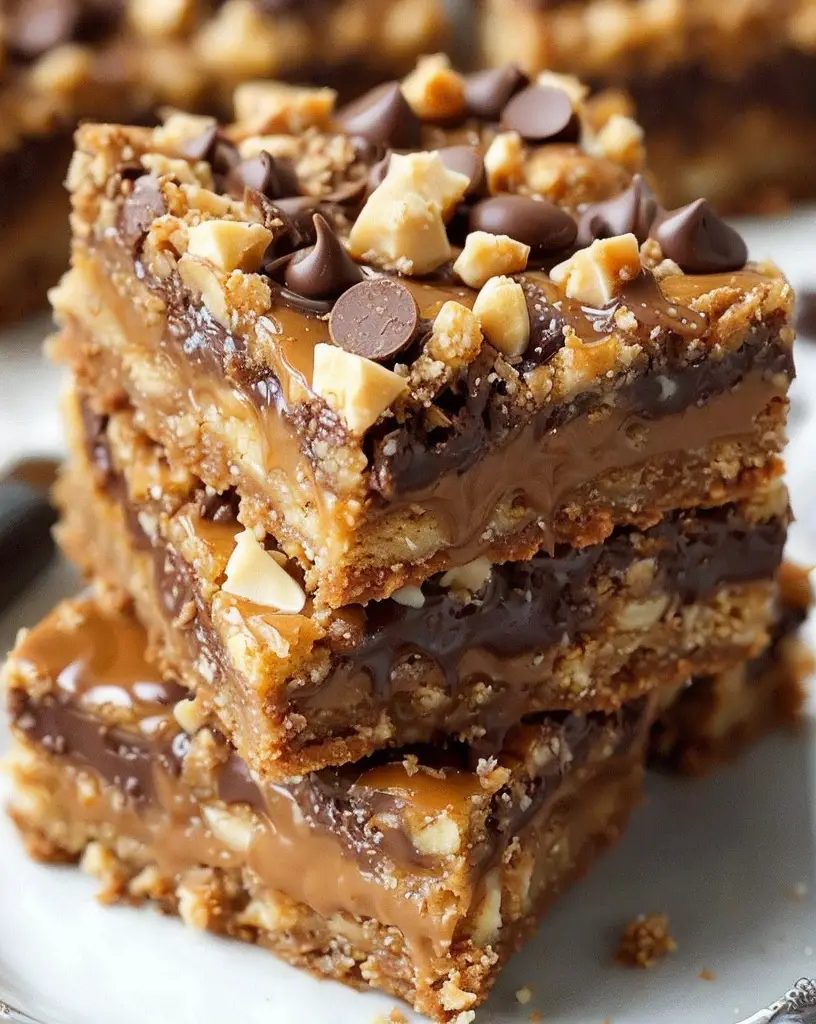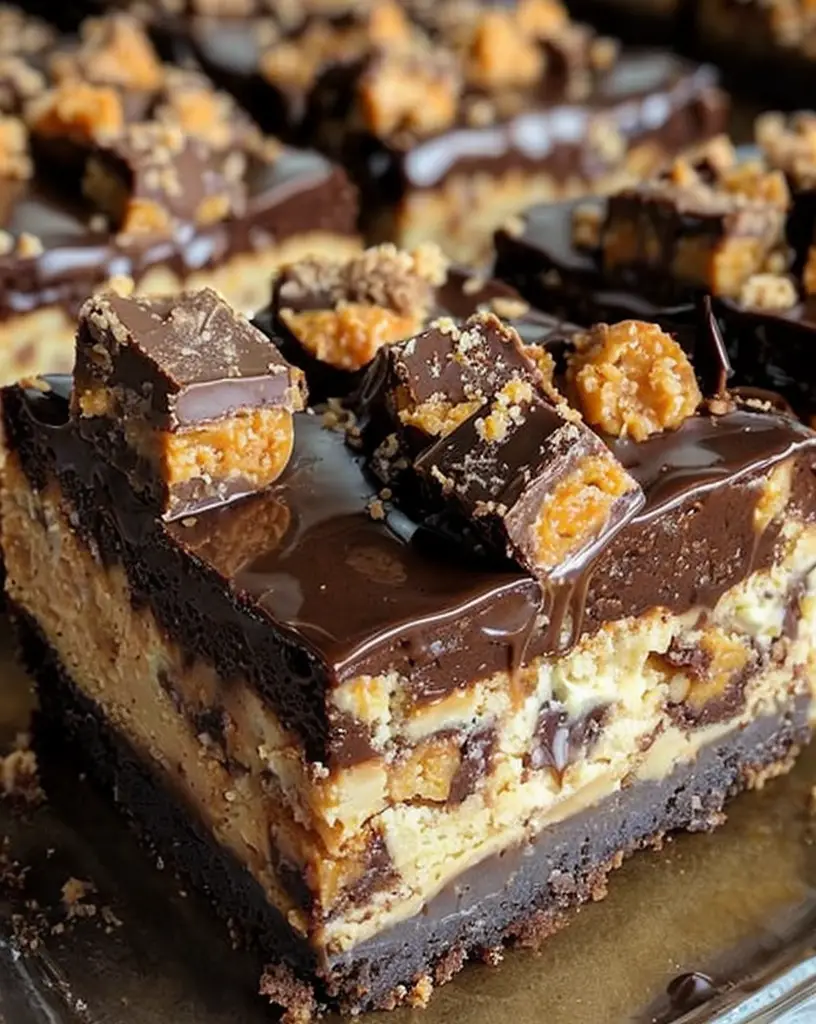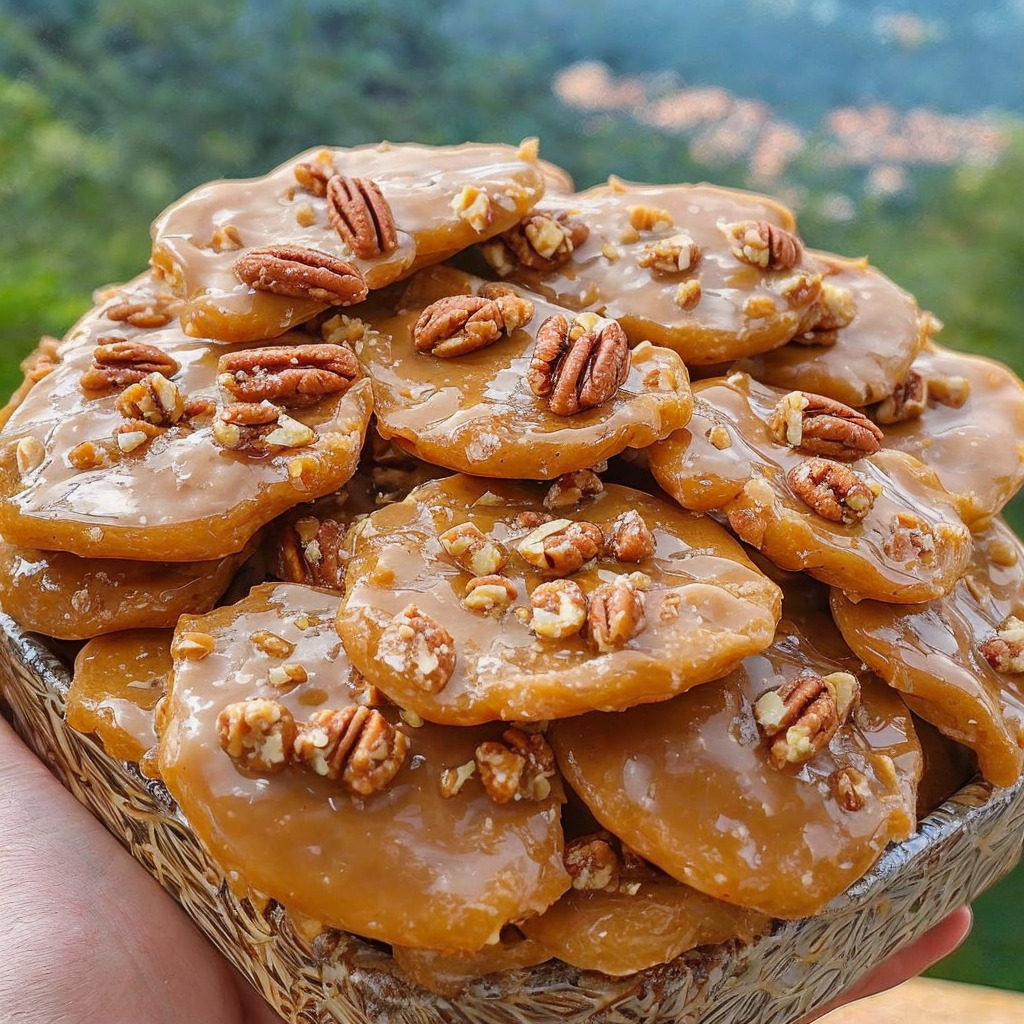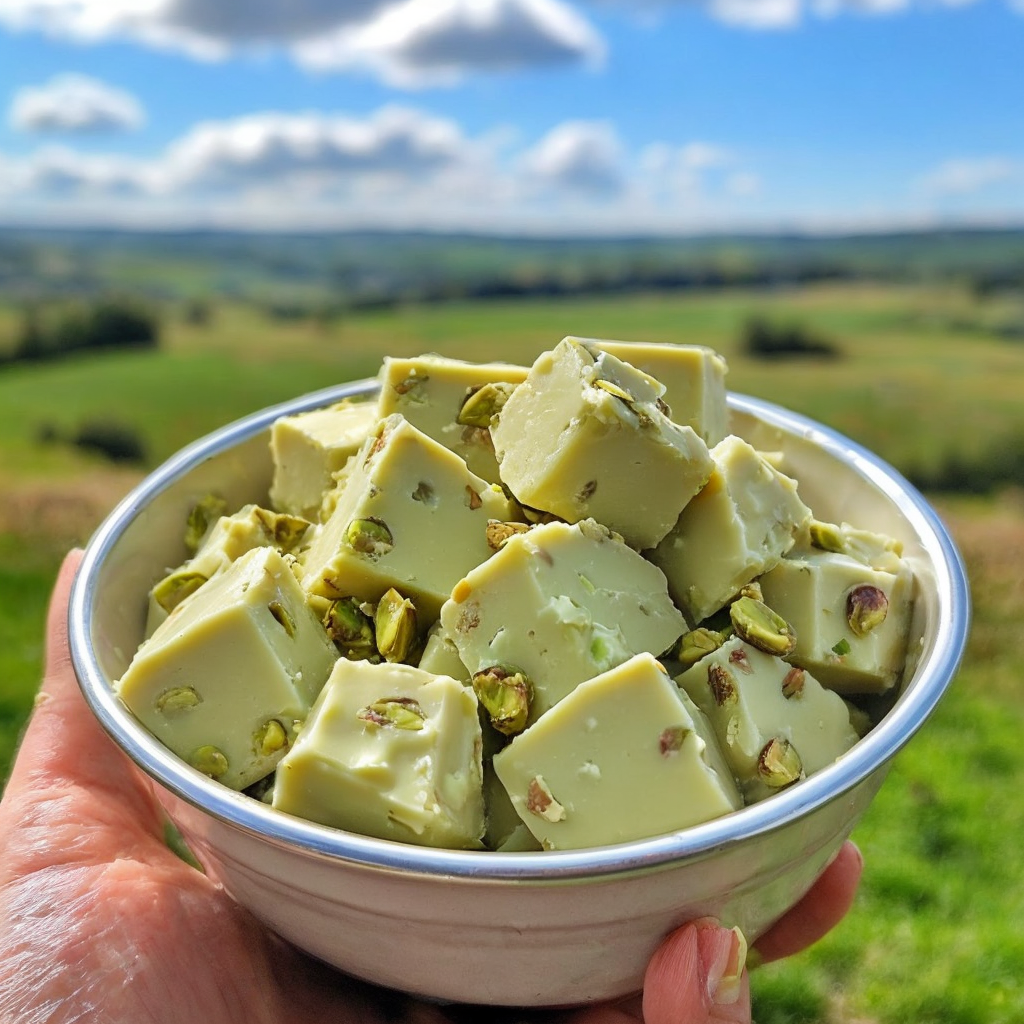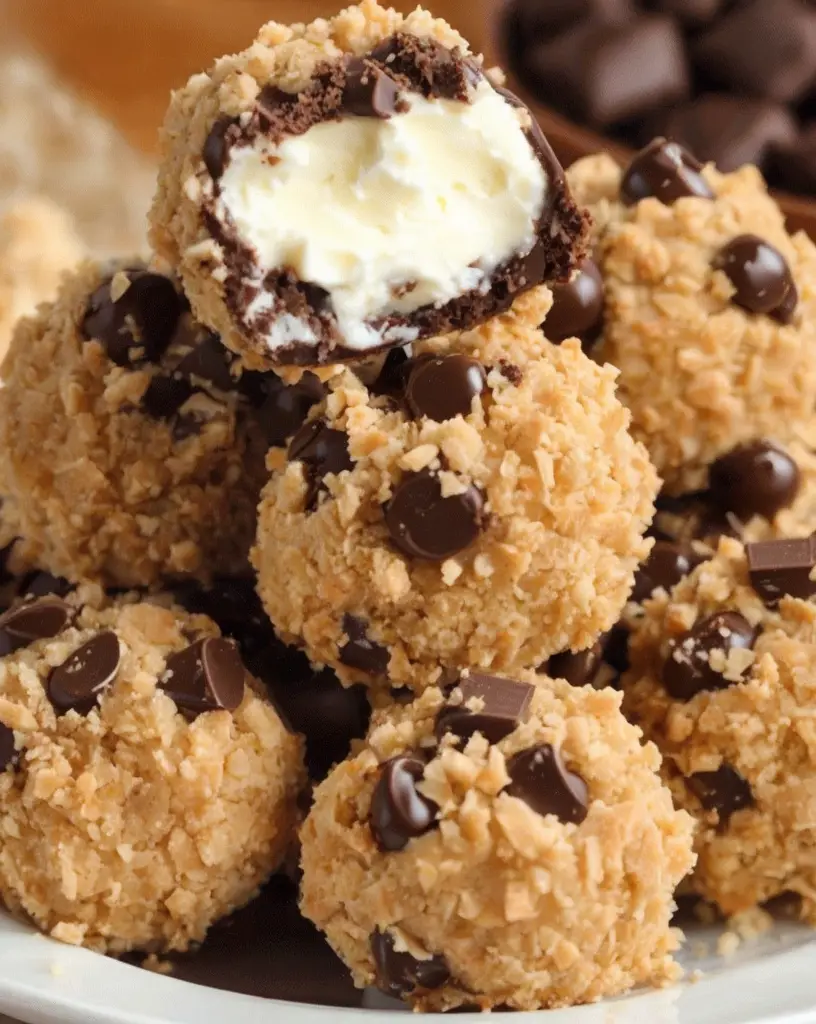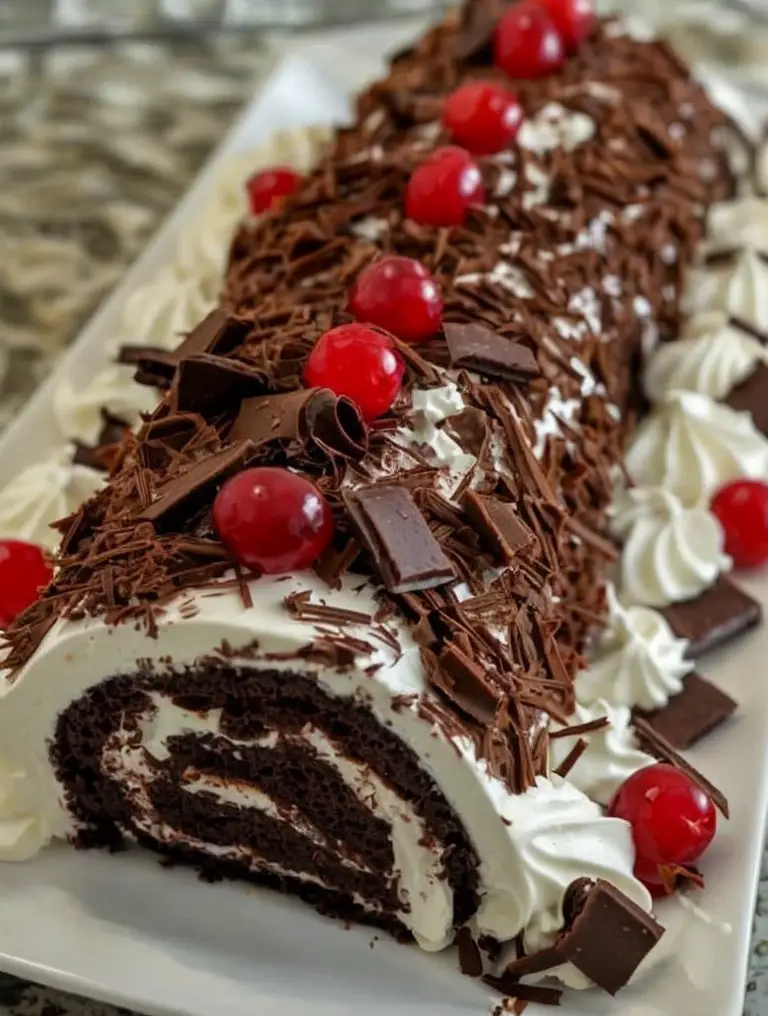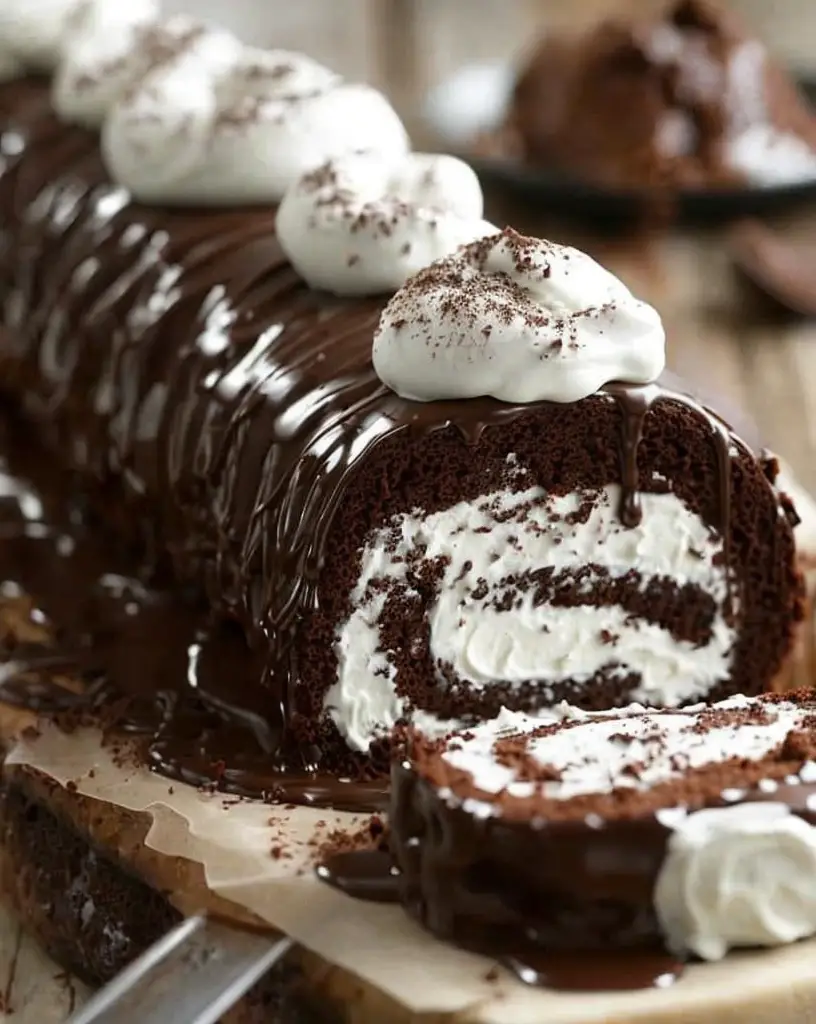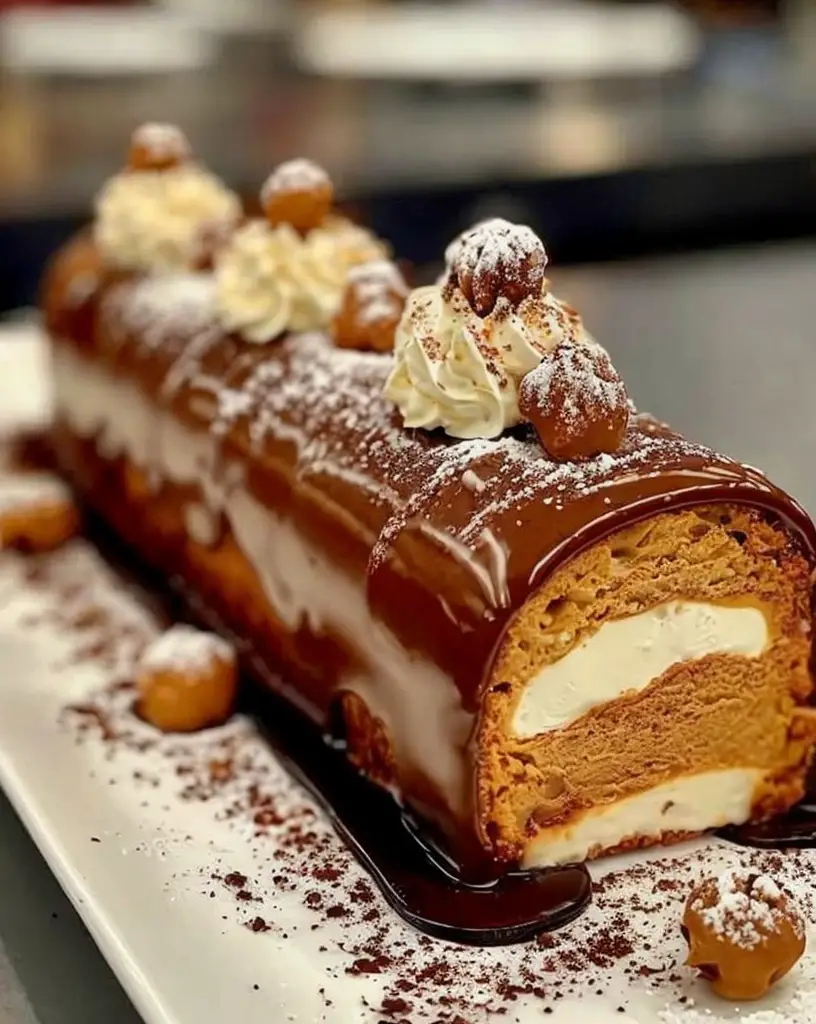Gooey Chocolate Toffee Dessert Bars: The Ultimate Easy Dessert Delight
Are you ready to dive into a luscious world of chocolatey goodness? Our Gooey Chocolate Toffee Dessert Bars are more than just dessert; they’re an experience. With rich layers of melted chocolate intermingled with crunchy, buttery toffee pieces, each bite will transport you to a realm of pure indulgence. These easy-to-make bars capture the essence of everything decadent with minimal effort. Whether you’re hosting a party or simply craving something sweet, these dessert bars are the answer to your dessert dreams.
Quick Recipe Highlights
- Flavor Profile: A balanced blend of rich chocolate with a hint of buttery toffee and a touch of saltiness.
- Texture: Creamy and gooey with a satisfyingly crunchy top layer that delights in each mouthful.
- Aroma: Irresistible, warm chocolate mixed with the nutty scent of caramelized toffee.
- Visual Appeal: A beautiful, glossy chocolate surface speckled with toffee pieces, sure to catch anyone’s eye.
- Skill Level Needed: Perfect for beginners and seasoned bakers alike, requiring only basic mixing and baking techniques.
- Special Equipment: A basic baking pan, mixing bowls, and an oven are all you need.
Recipe Overview
- Difficulty Level: Rated easy for its straightforward preparation and minimal required skills, perfect for all cooking levels.
- Category: This recipe falls neatly into the dessert category, ideal for sweet lovers.
- Cuisine: An indulgent fusion of American dessert tradition with a touch of international chocolate finesse.
- Cost: Affordable; using common pantry staples and a couple of special treat ingredients makes it budget-friendly.
- Season: Suitable for any season, its comforting richness pairs well with both chilly winters and sunlit springs.
- Occasion: Ideal for festive celebrations, casual gatherings, or a delightful family dinner dessert.
Why You’ll Love This Recipe
The flavor and texture of these Gooey Chocolate Toffee Dessert Bars are what elevate them to the top of our dessert list. Each bite delivers an explosion of decadent chocolate harmoniously mixed with the buttery crunch of toffee. The simplicity of preparation means you can whip up a batch whenever the sweet craving hits, without a fuss or stress. They’re also an excellent source of entertaining value; watch your guests’ eyes light up with delight as they take their first bite.
With a depth of flavor and a richness that’s surprisingly light on calories, these delicious bars offer great nutritional value – perfect for satisfying your sweet tooth without over-indulgence. Their straightforward preparation is conducive to busy schedules and their versatile nature makes them fantastic for bringing people together whether at family meals or larger gatherings. Not to mention, these bars are an incredibly cost-effective treat. With few ingredients that are easy to find and affordable, they’re a go-to for anyone who wants an economical yet impressive dessert option.
Historical Background and Cultural Significance
Chocolate dessert bars have a long-standing tradition in American culture, partly inspired by European dessert styles. The use of toffee adds a delightful twist that connects British candy-making traditions to these already rich creations. Over the years, dessert bars have evolved and emerged as a staple in bake sales, potlucks, and family gatherings across the globe.
The cultural significance of these little delights is noteworthy, as they have managed to carve a niche in the dessert world thanks to their adaptability and crowd-pleasing qualities. From school events to community gatherings, these bars are a juggernaut of culinary satisfaction. Variations abound, with some regions adding nuts or fruity elements to reflect local tastes and traditions. Yet, what remains universal is their ability to bring joy with their heavenly taste and cultural versatility.
Ingredient Deep Dive
Chocolate has a rich history rooted in ancient Mesoamerican cultures, where it was revered as a divine gift. Besides its cultural significance, chocolate is laden with antioxidants, which are beneficial for health. When selecting chocolate for your dessert bars, opt for high-quality dark or semi-sweet varieties for depth. Store chocolate in a cool, dry place to maintain its integrity.
Toffee, with Anglo-Saxon roots, brings a nostalgic, buttery crunch that contrasts beautifully with the smooth chocolate. Packed with energy and essential sugars for metabolic functions, it’s also a joy to snack on. When shopping for toffee, choose crisp and fresh variants and store them in airtight containers to avoid moisture. These key ingredients transform a simple chocolate bar into a blissful dessert experience.
Common Mistakes to Avoid
- Avoid overmixing the ingredients as it can lead to a dense and cakey texture instead of a gooey delight.
- Ensure your oven is preheated correctly to prevent uneven cooking and maintain the perfect soft center.
- Don’t leave the bars in the oven too long. Slight underbaking ensures the gooey center we’re aiming for.
- Choosing low-quality chocolate undermines the overall flavor; invest in good chocolate for the best results.
- Let the bars cool thoroughly before cutting to prevent them from crumbling into a mess.
- Using too high of a temperature will cook the edges too quickly, leading to hard and burned outsides.
- Skipping the parchment paper can make removing the bars difficult, risking breakage.
- Ignoring toffee freshness leads to clumps instead of an even crunchy distribution.
Essential Techniques
Mastering the art of making perfect Gooey Chocolate Toffee Dessert Bars begins with understanding how to melt chocolate properly – a critical step for achieving that luscious, creamy texture. The double-boiler method ensures even melting, preventing scorching and loss of flavor. Watch for a smooth, glossy finish as your cue for success.
Equally important is mastering the right balance of mixing the ingredients. Overmixing introduces too much air and can alter the final texture, making the bars too sponge-like. Gently folding ingredients until just combined preserves the rich, gooey center we crave. Understanding these key techniques ensures your dessert bars are nothing short of amazing each time you make them.
Pro Tips for Perfect Gooey Chocolate Toffee Dessert Bars
Ensure that each butter and sugar layer is evenly spread for consistent texture and flavor throughout the bars. Use fresh, high-quality ingredients for the richest taste and aroma. When melting chocolate, adding a teaspoon of coconut oil can give the bars a glossy, professional finish; it’ll also make slicing easier.
Chill the mixture for a few minutes before baking for better definition in the layers. Consider trying sea salt flakes on top before oven time to create a sweet-salt juxtaposition that elevates the flavor profile. If you enjoy nutty flavors, try adding finely chopped pecans or walnuts evenly between the layers for added richness. Finally, allow cooling time, but not too much, to enjoy them warm, just enough for serving stability but gooey enough for pleasure.
Variations and Adaptations
The beauty of Gooey Chocolate Toffee Dessert Bars lies in their flexibility to adaptations. For regional variations, consider adding native nuts or a touch of spiced warmth from cinnamon or nutmeg in colder months. Seasonal adaptations can involve adding crushed peppermint for a festive winter touch or fresh berries during summer for a fresher twist.
Dietary modifications are possible by using gluten-free flour or dairy-free chocolate for those with specific diets without sacrificing flavor and texture. Explore flavor variations by integrating orange or mint essence into the chocolate for a unique twist. Texturally, experimenting with different chocolates – from bittersweet to milk – changes the final mouthfeel. Presentation can vary; arrange bars in a decorative pattern dusted with powdered sugar for an elegant finish.
Serving and Presentation Guide
Plated beautifully, Gooey Chocolate Toffee Dessert Bars can transform from a casual treat to an elegant dessert with just a few tweaks. Use a sharp knife dipped in hot water before slicing to get clean edges, then dust each slice with a light sprinkle of confectioners’ sugar for a touch of charm. Garnish with a drizzle of caramel or a small scoop of vanilla ice cream for added indulgence.
For a traditional touch, serve these bars warm on a classic dessert plate adorned with a dollop of whipped cream and a sprinkle of finely chopped nuts. Alternatively, for modern flair, present them in a staggered stack on a chic slate board for a more contemporary aesthetic. Ensure the bars are served at room temperature or slightly warmed to fully appreciate their gooey texture.
Wine and Beverage Pairing
A rich dessert like Gooey Chocolate Toffee Dessert Bars deserves an equally opulent wine pairing. Opt for a late harvest Riesling or an ice wine, whose sweetness complements the bar’s rich chocolate textures perfectly. For red wine enthusiasts, consider a deep, bold port that matches the chocolate without overpowering it.
If you’re looking for non-alcoholic alternatives, a creamy hot chocolate transforms this dessert into a warming winter affair. Coffee pairings like a frothy cappuccino can add depth and richness to each bite, highlighting different flavor notes in the dessert. Remember, serving beverages at the right temperature enhances the palatable experience, making them equally crucial as the dessert itself.
Storage and Shelf Life
To maintain the freshness and flavor of Gooey Chocolate Toffee Dessert Bars, store them in an airtight container at room temperature for up to three days. For longer preservation, you can refrigerate them, extending their life for up to a week, while retaining the gooey texture through careful reheating.
Using a soft, airtight container avoids the dessert bars becoming too hard or losing their chewiness. Look for signs of spoilage such as off-smells or visual mold to ensure safety. To reheat, pop them in a low oven or microwave until just warm, avoiding overbaking. The bars freeze well; wrap them individually for easy access to a gooey treat anytime.
Make Ahead Strategies
Maximize your time with make-ahead strategies for these delectable bars. Prepare each layer up to 24 hours in advance, storing each separately to maintain freshness. Assemble them right before baking to keep clear layers intact and gooey.
Store pre-mixed ingredients in sealed, designated containers labeled with content and dates to prevent confusion and maintain organization. For layered pre-baking, store in the refrigerator to firm layers, stabilizing before baking for sharper distinction between flavors. This method saves time without compromising quality, allowing you to effortlessly create these delightful bars, fresh as intended.
Scaling Instructions
Scaling up to accommodate a bigger crowd or just for the sheer joy of more Gooey Chocolate Toffee Dessert Bars? It’s straightforward with a few adjustments. Doubling or tripling the recipe is as easy as adjusting the ingredient quantities proportionally, ensuring that each component balances the others for consistent flavor.
Equipment choices matter; larger pans may require slight timing adjustments, so watch closely to maintain gooey centers. Alternatively, halving the recipe keeps things simple for smaller gatherings, reducing any excess without sacrificing taste. Whatever your batch size, focus on baking times and proportions to capture the perfect blend of gooey and crunch.
Nutritional Deep Dive
Each serving of Gooey Chocolate Toffee Dessert Bars is more than indulgence; it’s a well-balanced nutritional entity. Rich in carbs for quick energy, with fats contributing to satiety, they provide satisfaction without the guilt. High-quality chocolate adds antioxidants linked to heart health and improved mood.
The integration of toffee provides quick sugars for instant vitality, boosting metabolic processes. Portions control is crucial, ensuring nutritional intake aligns with dietary goals. Mindful consumption, tailored to individual energy needs, allows you to appreciate the dessert benefits while savoring every delectable bite. This blend of taste and nutrition enriches the dessert experience without overindulgence.
Dietary Adaptations
To accommodate dietary needs, consider slight modifications. For a gluten-free version, use certified gluten-free flour blends, keeping texture similar with tender bakes. Dairy-free options allow substitutions like coconut oil or dark dairy-free chocolate, maintaining richness while adhering to dietary preferences.
Vegan modifications are viable too, choosing egg-replacements and plant-based chocolate adaptations without compromising flavor. For low-carb diets, experiment with coconut flour alternatives and sugar replacements to maintain nutritional balance. Each tweak maintains the beloved characteristics of Gooey Chocolate Toffee Dessert Bars while aligning with personal nutritional plans and dietary discipline.
Troubleshooting Guide
Texture issues like dry or crumbly bars often indicate overbaking or insufficient moisture in the mix. Ensure perfect results by monitoring bake times and checking oven calibration. Flavor imbalance, such as excessive sweetness, can be adjusted by altering the toffee ratio or adding a touch of salt for equilibrium.
Temperature concerns also impact texture; keep a close eye on oven settings or consider investing in an oven thermometer for precise results. Equipment challenges, like uneven baking, benefit from rotating pans halfway through cook time. With thoughtful ingredient substitutions, maintain the beloved texture, and ensure success by adhering to these detailed solutions.
Recipe Success Stories
The Gooey Chocolate Toffee Dessert Bars have become a staple at countless family gatherings due to their simplicity and universal appeal. Many have shared stories of success in adapting this versatile recipe to match personal tastes or dietary requirements without detracting from its signature gooey delight.
Community feedback has highlighted successful variations such as the addition of caramel swirls or using almond flour for a gluten-free twist. Capturing the beauty of these bars proves simple with basic photography tips shared by users online; a soft natural light enhances their appeal, making them as delightful visually as they are to eat.
Frequently Asked Questions
To ensure gooey dessert bars, avoid overmixing the batter and ensure you bake at the correct temperature. Watch bake times closely since slight underbaking helps maintain a soft center.
Can I substitute dark chocolate with milk chocolate?
Yes, milk chocolate can be substituted for a sweeter taste; adjust sugar levels accordingly to not overpower other flavors.
Is fresh toffee necessary, or will older toffee suffice?
Fresh toffee ensures the best crunch and flavor quality. Older toffee may become chewy and affect the overall texture.
What’s the best way to melt chocolate?
Using a double boiler or microwaving in short intervals, stirring in between, prevents scorching for a smooth, glossy texture.
How long can these bars be stored?
Store in an airtight container at room temperature for up to 3 days. Refrigerate or freeze for longer storage, ensuring freshness.
Can I add nuts to this recipe?
Absolutely, finely chopped nuts like pecans or almonds can be added for extra texture and depth of flavor.
Is it possible to make these bars vegan?
Vegan adaptations are easy with dairy-free chocolate and subbing eggs with flaxseed or a store-bought egg replacement.
How does changing flour affect the taste and texture?
Using different flours, such as coconut or almond, can alter moistness and density; experiment to find balance that suits taste preferences.
Are there specific plating techniques for optimal presentation?
Slicing with a hot knife ensures clean edges, while sprigs of fresh mint or dusted powdered sugar can add elegance.
My bars turned out dry. What went wrong?
Dry bars may result from excess baking time or temperature. Calibrate your oven and aim for precise timings to retain moisture.
Can I make these bars ahead of time?
Absolutely, prepare different layers separately in advance, then assemble and bake when ready for a fresh outcome.
Could I replace toffee with caramel?
Yes, caramel works as an enjoyable alternative, introducing a softer texture and lighter profile.
Additional Resources
Explore more decadent chocolate recipes to expand your dessert repertoire. Delve into technique guides focused on mastering baking basics to refine your skills further. Discover ingredient information tourism to gain deeper insights into unique variations and adaptations around the world.
Seasonal variations can be adventured with through resources focusing on seasonings and accompanying flavors that elevate chocolate desserts to an exquisite tier. Keep your kitchen well-equipped with recommended tools and gadgets to successfully execute recipes with ease. Utilize these resources to continuously evolve your culinary expertise and craft perfect desserts every time.
Join the Conversation
Share your love for Gooey Chocolate Toffee Dessert Bars and exchange tips with fellow dessert enthusiasts. Connect on social media, where you can post your delicious creations and engage with a community of chocolate lovers. Share photography tips to capture your creations beautifully and inspire others through your artful presentation.
Encourage friends and family to leave their reviews and suggestions, fostering a dynamized space where ideas thrive. Experiment with recipe variations and challenge others to do the same, broadening the horizons of creativity through both innovation and tradition. Join a vibrant community celebrating the sweet pleasures of baking, each dessert contributing to collective joy.
The Recipe
Gooey Chocolate Toffee Dessert Bars
Serves: 12 bars
Prep Time: 15 mins
Cook Time: 25 mins
Total Time: 40 mins
Kitchen Equipment Needed
- Baking pan (9×9 inch recommended)
- Mixing bowls
- Whisk
- Spatula
- Knife
- Oven
- Parchment paper
Ingredients
- 1 cup butter, melted
- 2 cups graham cracker crumbs
- 1 can sweetened condensed milk
- 2 cups semi-sweet chocolate chips
- 1 cup toffee bits
- 1/2 tsp vanilla extract
- Pinch of salt
Directions
- Preheat your oven to 350°F (175°C) and line a 9×9 inch baking pan with parchment paper.
- In a bowl, combine melted butter and graham cracker crumbs until well moistened.
- Press the mixture firmly into the prepared baking pan to form an even crust.
- Pour sweetened condensed milk evenly over the crust layer.
- Sprinkle the chocolate chips and toffee bits uniformly over the milk layer.
- Gently press down the toppings to embed them slightly into the milk layer.
- Bake for 25 minutes or until the edges are golden and the center appears set.
- Remove from oven and let cool completely before slicing into bars.
- Optional: Refrigerate for an additional 30 minutes for firmer bars.
Recipe Notes
- For a nuttier flavor, add 1/2 cup of chopped pecans or walnuts.
- Use gluten-free graham crackers for a gluten-free variation.
- Add a hint of sea salt on top before baking to enhance flavor complexity.
